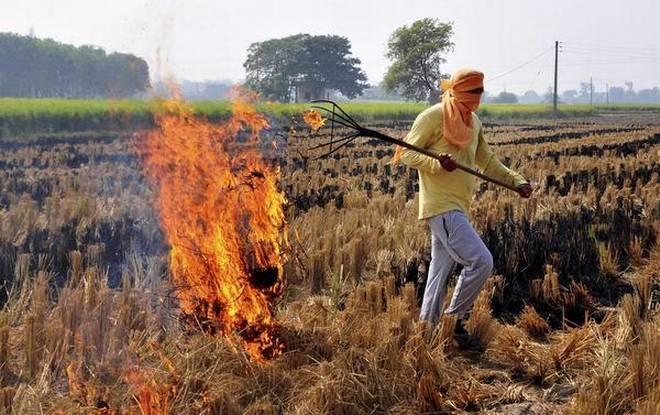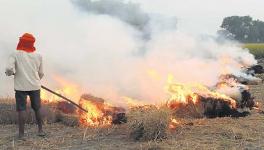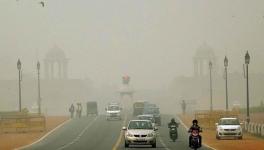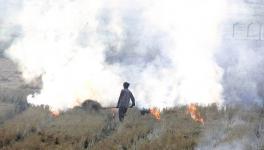IIM-Amritsar Students Suggest Alternative to Burning Stubble

A group of students of the Indian Institute of Management-Amritsar (IIM-A) have come up with new ways to farmers to utilise paddy straw and earn money instead of burning it.
The study, conducted by students Sawan Khapne, Shivam Rana, and Shailendra Singh, dwells upon the alternative ways to utilise paddy waste and was carried out for a period of three months from July to September.
Stubble burning in Punjab and Haryana is a major cause of air pollution not only in the two states but also in the national capital. Every year, Punjab annually generates 220 lakh tonne of paddy stubble.
Paddy is grown on 30 lakh hectares in Punjab. After harvesting, about 20 million tonnes of paddy straw is left in the fields. It is estimated that 15 million tonne of paddy straw is burnt every year.
Read more: Paddy Straw: A Burning Problem
Most of the stubble burning takes place over three weeks in October-November, releasing particulates and smog-forming carbon monoxide and nitrogen oxide, which drift from the fields over almost the entire Indo-Gangetic plain. This pollution contributes around 12-60 per cent of particulate concentrations depending on the generation of other pollutants in different locations, winds, temperature and other local factors. Farmers themselves are doubly harmed, by the local air pollution caused, and by the loss of soil nutrients such as Nitrogen, Potassium, Phosphorus and Sulphur, due to the burning.
State Aid: Only on Paper?
In an effort to solve the problem of stubble without burning, the state government has provided agro-machines and other equipment, including mulchers and choppers, at subsidised rates to farmers and cooperative societies with a Central outlay of around around ₹650 crore for 2018-2020.
However, farmers continue to defy the ban on stubble burning, claiming they are compelled to do so in the absence of any financial support from the government for farm waste management. The members of the Kisan Morcha protested outside Deputy Commissioner’s office on Friday in Punjab's Sangrur after the state government failed to provide proper machinery for stubble burning.
The farmers also said that the facilities the government boasts of providing are only on paper.
ANI reported the farmers citing their helplessness to adopt any alternative in the absence of any assistance from the state machinery.
Union Cabinet Minister of Food Processing, Harsimrat Badal on Friday, reacted to stubble burning in Punjab by stating that around 600-700 farmers have committed suicide due to the state government's pressure and harsh policies. He claimed that the Centre has given money to the state for providing machinery to the farmers. He also brought up the issue that the Chief Minister Amarinder Singh should set up industries to generate electricity with stubble.
Earlier on Thursday, the farmers in Punjab's Patiala had also resorted to burning stubble stating that they didn’t have any other alternative.
There are many options for handling and utilisation of paddy straw stubble, like in situ management of stubble, to plough the stubble back into the ground or the tractor-mounted “Happy-Seeder” machine developed by Punjab Agricultural University, which adopts a no-tillage system to cut the stubble close to the ground and collects it, sows wheat seeds for the next crop, and spreads the cut straw on the field as mulch. But the problem is the Rs. 1.5 lakh cost of the machine, which even with the 33 per cent subsidy available for its purchase, remains inaccessible to a large section of the farmers, This, shows that despite the technologies being available, the lack of appropriate financing and institutional mechanisms mean that they do not amount to anything.
From Burning to Making Money
Against this backdrop, three students from IIM-Amritsar visited the Khot Khalsa area in Amritsar and interacted with farmers to understand their problems and the reasons for burning stubble. The farmers acknowledged that despite government efforts, burning still remained an easy option to dispose of straw. The study proposed mushroom cultivation and gasification process for using paddy straw in producing biochar to be converted into biofuel, besides management of residue in fields by growing crops with leftover stubble. It also suggested use of straw in making bio-concrete for the construction of buildings.
For effective implementation of these alternatives, the students focused on 31 villages of Verka, near Amritsar, and divided these into four clusters for an easy distribution of equipment and collection of paddy waste.
“The supply chain management is basically a journey of procuring a thing till it reaches its destination. I have interacted with many farmers. The aim is to develop a pattern that can be followed as paddy is harvested,” said Dr Neeraj Bhanot, assistant professor, who supervised the study.
The straw can be procured from farmers by companies or NGOs termed as service providers. These service providers can take help of labourers engaged by government bodies or cooperative societies. The straw then needs to be transported to processing units or markets. The chain begins with farmers selling straw to the service provider. These service providers shall procure straw directly from fields or from traders.
“We have not only designed this chain, but have also proposed the alternative uses. The chain shall also help farmers make money by selling straw,” said Sawan Khapne.
Get the latest reports & analysis with people's perspective on Protests, movements & deep analytical videos, discussions of the current affairs in your Telegram app. Subscribe to NewsClick's Telegram channel & get Real-Time updates on stories, as they get published on our website.


















